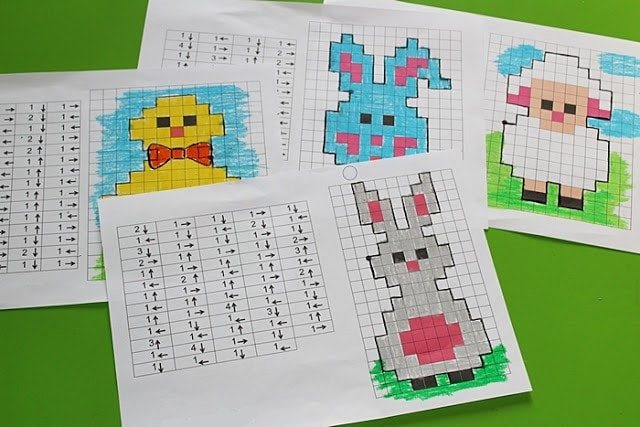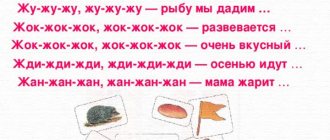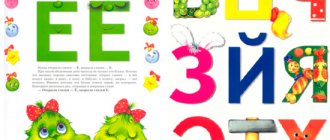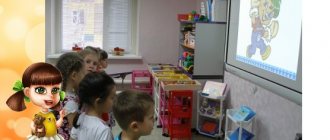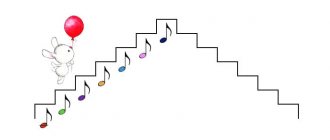What is graphic dictation?
Graphic dictation for preschoolers is a unique game that is interesting both for children in kindergartens and for 1st grade students. The child is given a sheet of paper in a box; the younger the child, the larger the markings; the starting point is marked on the form.
The teacher explains the task, and the “dictation” begins. You need to listen carefully to the step-by-step instructions and draw lines several cells up, right, left, down or diagonally.
The end result should be a whole drawing. It could be some kind of animal: an elephant, a giraffe or a horse - a plant, a flower, and for older children a castle or an intricate pattern.
If the child gets distracted by his desk neighbor or another trifle and listens to the task, then the drawing will not work. This helps children realize how important it is to listen carefully to the teacher and not wander around.
In kindergartens, for such activities they usually use manuals by D.B. Elkonina or O.A. Kholodova. There is even a whole course of step-by-step lessons for children of different ages, developed by K.V. Shevelev.
Graphic dictation by cells. Drawings by squares for children
+5
Drawing by cells is a very exciting and at the same time useful activity for children. Today, performing graphic dictations has become an incredibly popular activity that has won the hearts of many preschool children, and has also become an excellent assistant in preparing your child for school. By drawing in the cells of graphic dictations, the child develops writing skills, so to speak, “gets a steady hand.” With the help of such play activities, the child learns to be more attentive, develops logic, abstract thinking, perseverance and painstakingness. Drawing on the cells in a notebook teaches the child to navigate in space, and also helps to reinforce the concepts of up - down, right - left. Mathematical dictations, as an educational game for children, are used in various places: at home, on vacation, at sea, in the country, or in special additional classes to prepare a child for school. The most important thing here is to interest the child, to say that in the end you will get an unknown picture, which can then be colored with pencils or felt-tip pens. Carrying out graphic dictations helps parents and teachers systematically prepare their child for school and prevent such typical learning difficulties as underdeveloped spelling vigilance, restlessness and absent-mindedness. The better your child is prepared for school psychologically, emotionally and intellectually, the more confident he will feel and the easier his adaptation period in elementary school will be.
Tips for doing graphic dictation and rules for drawing pictures by cells . Adults must understand that this is still more of a game for a child than learning. During such an activity, the child’s mood and the friendly attitude of the adult are very important. To complete a graphic dictation you will need a piece of checkered paper, a simple soft pencil, and possibly an eraser. The whole dictation consists of drawing short lines on a regular notebook sheet in a box. It is advisable that the child does not take his hand off the notebook sheet while completing the task. The following notations are used in the diagrams below: the number of cells being counted is indicated by a number, and the direction is indicated by an arrow. Follow the arrows from left to right.
How to do graphic dictation
To begin, put a mark on a notebook sheet in a box that will serve as the beginning of a report for the child. Please note that each drawing diagram always indicates how many cells need to be retreated from the edge and top to start the dictation. In the indicated place, you need to put a bold point. Now, on the child’s sheet, with your help, the starting point will be depicted. Explain to your child that from this point you need to start drawing lines (right, left, down and up), in the direction and with the number of cells that you name. Some preschoolers perceive new information well, while others constantly confuse the concepts of left and right. In order to make the task easier and not confuse the child, you can draw arrows ← and → in the corners of the notebook paper so that he remembers which side, where and what is on it. Now start completing the task. You will dictate to your child, and he will strictly follow your instructions, provided that he can count to ten. Count together if you need the required number of cells. Dictate clearly, without rushing, because the child must perceive everything by ear. During graphic dictation, make sure your child is on time. At the end of the work, look at how well the figure drawn by the child matches the task. If the baby made a mistake, find out together where exactly. Calmly help, use an eraser to erase the excess in the place where the mistake occurred. Do not scold your child if the child does not succeed right away. The duration of the lesson is 15 – 20 (maximum 30) minutes. And after completing the dictation, be sure to praise your child and ask if he liked this game? And will he play it with you next time?
Good luck in completing interesting tasks on cells!

Drawings by cells for children Graphic dictations
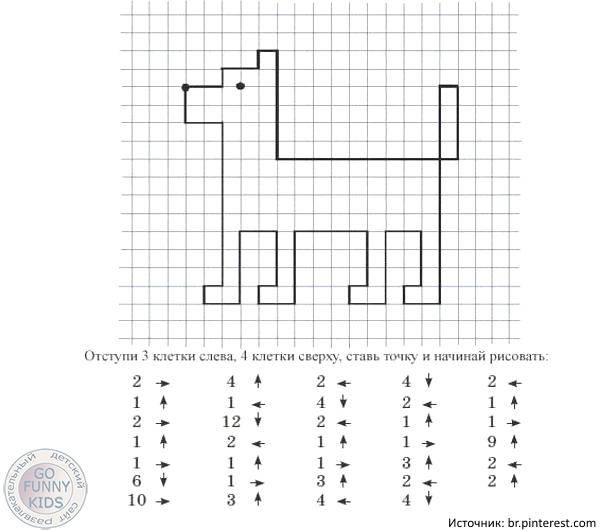
Dictation by cells Graphic drawings for children Games by cells Drawings by cells for children Dictation by cells Mathematical dictation by cells Motor skills. Drawing by cells
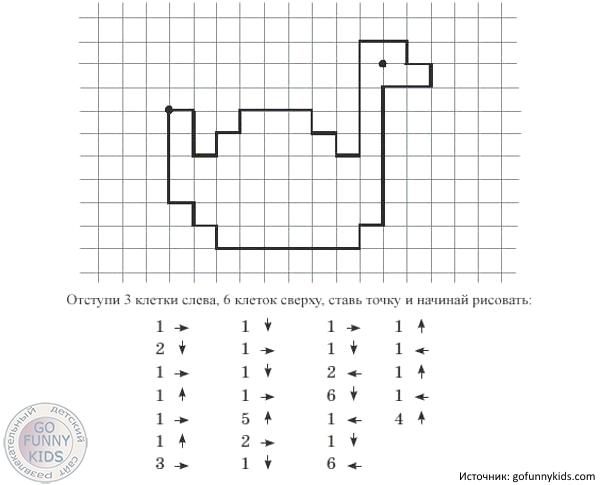
Graphic dictations for children Dictation by cells Easy and beautiful drawings by cells in a notebook

Graphic dictation Graphic dictation by cells for preschoolers 6-7 years old Graphic dictation for children
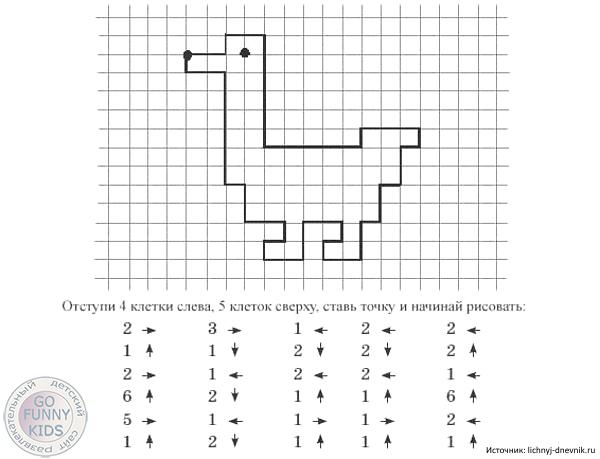
Graphic dictation by cells Graphic dictation for preschoolers Graphic dictation for children Draw by cells. Mathematical dictation
Read other similar articles:
Complete the half by cells
Drawing by cells. Symmetrical drawings in a notebook
Math tutorial. Drawing a pattern by cells
Preparing your hand for writing. Draw by cells and dots
Facebook Comments
Tags
Educational games for children
What will you need to complete the tasks?
Another advantage of the technique: simplicity and accessibility. To complete tasks, it is not necessary to buy special manuals or various office supplies. All you need to do is take a checkered piece of paper, a simple pencil and an eraser. Therefore, the exercise can be done at home, while waiting to see a doctor, or on a long trip.
Note!
- Dog coloring page - useful tips on how to draw a dog. Instructions with basic drawing steps for children (160 photos)

Sketches: a master class on creating simple and complex drawings with your own hands with step-by-step diagrams for beginners + photo examples of original works

Easy gouache drawings - TOP-160 photos and step-by-step instructions for drawing with gouache. Best Reviews of Easy Drawings for Beginners
To diversify the lesson and interest the kids, you can bring colored pencils and then color the resulting drawing. And to draw diagonal lines in a drawing, you may need a ruler.
If the lesson is held in a classroom, be sure to remove all unnecessary items from the desk. Instructions and tasks for graphic dictations in grade 1 can be found on the Internet and printed. Parents should not create assignments on their own.
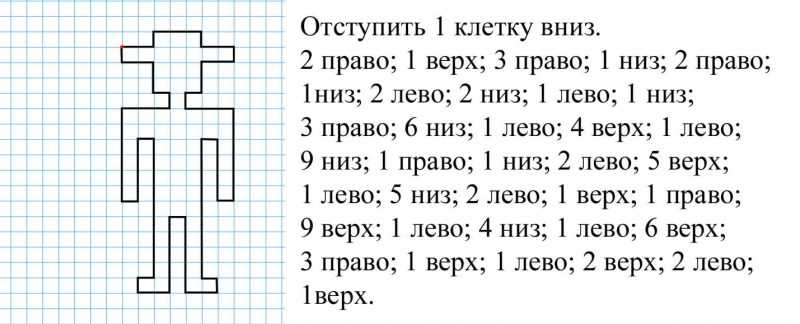
Execution Rules
Graphic dictations, during which you need to draw a geometric pattern, are best used in math lessons, for example in 1st grade. Execution is related to the coordinate system, counting, and geometric shapes. The methodology consists of several stages:
- Prepare a piece of squared paper for the student. Keep a ready-made version of the dictation with you.
- Place a dot on the student paper. This will be the start of the countdown. Or have your preschooler do it themselves, explaining how much space to give.
- For a child just beginning to learn, draw arrows on paper that indicate the directions of the sides. This makes it easier to get the correct result. In subsequent lessons, hints will no longer be needed.
- Explain that step 1 is a cage. If we take 2 steps, the line goes 2 cells.
- The teacher dictates the working conditions step by step.
On the finished sheet for the teacher there is a drawing, a coordinate plane consisting of arrows and numbers. For example, to draw a Christmas tree, draw a line horizontally in 1 cell, vertically - 3 cells, diagonally - 3 cells, and so on. More often it’s just arrows and numbers without words.
The teacher explains which lines, where, and at what distance the preschoolers draw. Instructions are given one after another, without rushing.
- After completing the written assignments and obtaining the results, draw conclusions about the lesson and the efforts of the preschoolers.
Scold him for inattention if the child was distracted by trifles, or praise him for achievements and a well-done task.
Important ! There's no need to rush. If your preschooler doesn’t keep up, usually in the first lessons, wait for him. Skipping even one step or writing incorrectly will ruin the finished result. Set the time frame gradually, speeding up the process by a couple of seconds from lesson to lesson.
Recommendations for classes
Sometimes during lessons with a child various difficulties may arise. To prevent this from happening, it is better not to forget a few tips from experienced teachers.
- Before the first lesson, you need to explain to your child the essence of the game. It's best to show with a simple example. Explain why the lesson is being taught. Motivate for successful execution.
- The teacher should give step-by-step instructions, noticing whether the child is keeping up. All questions that arise must be answered immediately, without delaying until the end of the lesson. It is better not to repeat directions several times, so as not to confuse preschoolers.
- You need to carefully monitor the correct posture and position of the baby’s hands. Correct if the child is hunched over or holding a pencil incorrectly.
- It is advisable to ensure a calm atmosphere and silence in the classroom. This will help the baby concentrate and better perceive the teacher’s instructions.
- Make sure there is good lighting while practicing. This will make it much easier to complete tasks and help maintain good vision.
- The difficulty of tasks should be increased gradually. You should not immediately give complex drawings with many details, and on the contrary, a task that is too simple will seem boring to the child.
- There is no need to scold your child for mistakes. Don't forget, your child is just learning.
- Always notice your baby's successes. This will help him build self-confidence.
- It is necessary to control the time of classes so as not to overtire the child. Take small warm-up breaks periodically.
First lesson
The first lesson with graphic dictations at the age of 6, and for children of other ages, is somewhat different from subsequent ones. For the first time, it is better to follow clear instructions.
The lesson should be a trial lesson. There is no need to demand excellent results from kids. The goal of the lesson is to introduce the child to the principle of operation, goals and objectives of the exercise.
Note!
- Drawing ideas: TOP-200 photos of the best ideas for do-it-yourself drawings + reviews of techniques with simple drawing schemes
- Pencil drawings are easy and beautiful - a master class on pencil drawing for beginners. Simple diagrams with a description of the work + photos of the best drawing ideas
- How to draw a squirrel: TOP-120 photos of the best drawing methods and techniques. Step-by-step master class for beginners with examples of the best drawings
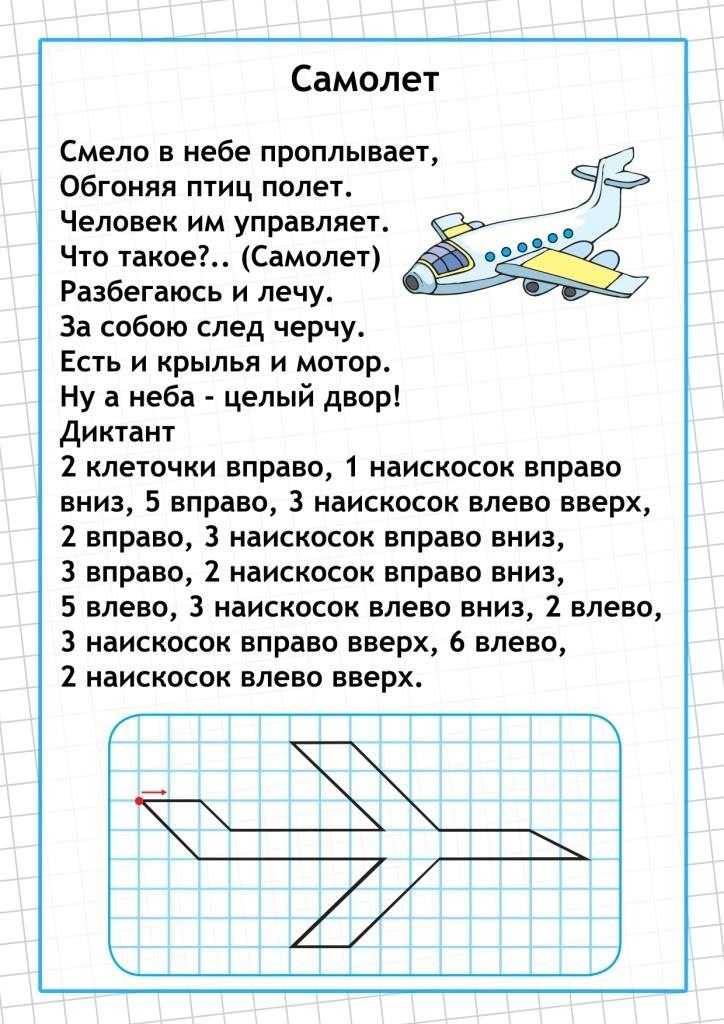
It is necessary to explain all this clearly and clearly, while stirring up the child’s interest in the task. For example, a teacher can say: “Children, today we will draw interesting figures. But I won’t tell you yet what it will be. You must listen carefully to my instructions in which direction and how many cells to draw the line, and not confuse right and left. We draw the pencil evenly without lifting it from the paper. And then we’ll see what kind of figure we get.”
It’s better to look at the first drawing together with the guys on the board. Conduct a so-called master class for beginners and children.
The teacher must note all the results of the work, keep a detailed diary of classes, thus monitoring and encouraging success, analyzing and explaining the most common mistakes made.
If the level of failure in the group is high, perhaps the pictures are too complex for children to understand and easier examples need to be selected.
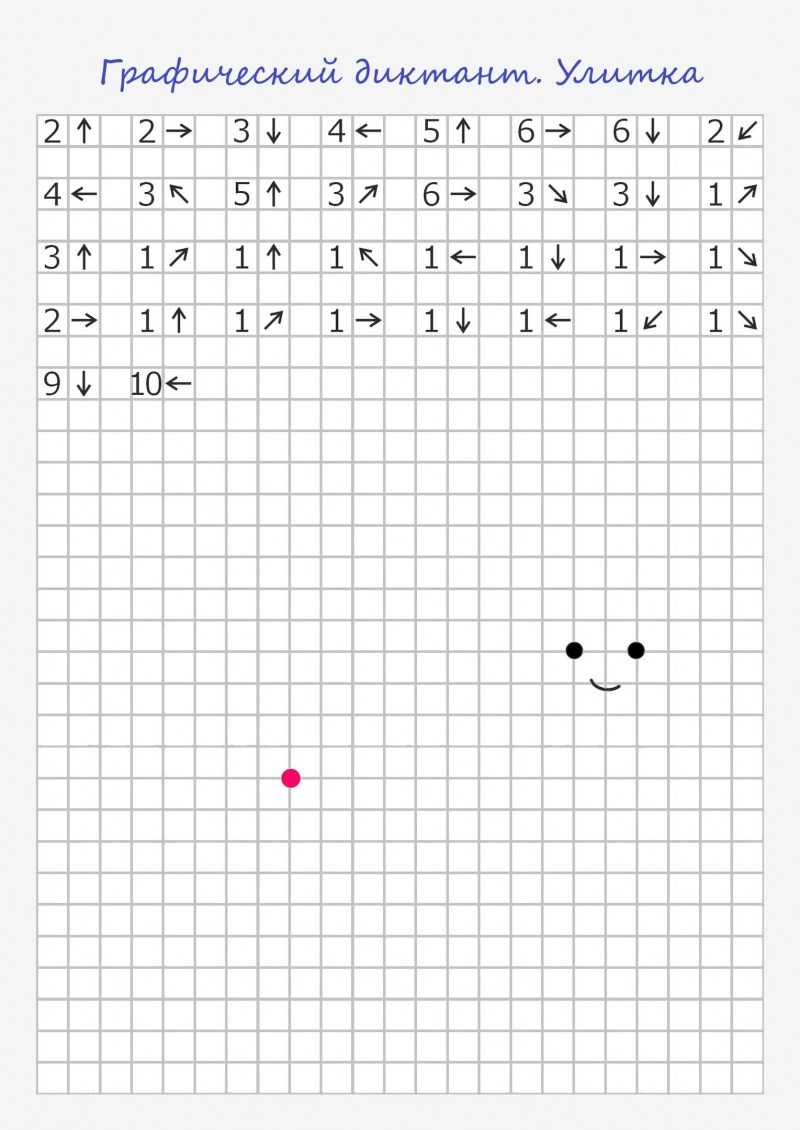
Note!
- How to draw anime - useful tips and simple diagrams for beginners. Instructions with the basic steps of drawing anime (160 photos)
- 3D drawings: TOP-150 photos of the best methods and techniques. Step-by-step DIY drawing master class for beginners

How to draw a girl's face with a pencil - instructions on how to draw with a pencil for beginners. Master class with a description of the technique + photos of the best drawing options
In subsequent lessons, you can complicate the tasks, reduce the completion time, organize speed competitions between preschoolers, give more complex or even unknown pictures, and after the lesson talk about the drawn figure.
Stages of conducting classes
It is worth noting that almost all dictations are complemented by relaxing games, simple sayings and finger exercises for relaxation.
During classes, children develop clear speech, develop fine motor skills and practice concentrating on those things that require increased thoughtfulness - the features of objects, replenishing their vocabulary (riddles for the resulting drawings).
The tasks are designed so that the child can solve examples “from simple to complex.” According to the principle of the graphic method, children quickly and easily remember the sequence of numbers and develop orientation in the direction of movement.

Before conducting a graphic dictation, the teacher explains the essence of the task
To conduct classes you need:
- The main stage consists of a conversation between the teacher and the children. It is necessary to explain the task, rules and features of the game.
- The teacher asks to leave only a squared notebook, a pencil and an eraser on the desk in case the child gets lost or does not have time to complete a step.
Preschool children are given notebooks with a size of up to 0.8 mm (large) to make it easier to concentrate on finger movements. Small cells are too “complicated” for tracing and drawing, so children 5-6 years old need to ensure the comfort of the process itself.
Below is an example of a graphic dictation for a 4-5 year old child:
| Stages | Step 1 | Step 2 | Step 3 | Step 4 | Step 5 | Step 6 | Step 7 | Step 8 |
| Block 1 | Right 1 | Up 3 | Right 2 | Up 1 | Right 1 | Down 3 | Right 6 | Up 1 |
| Block 2 | Right 1 | Up 1 | Right 1 | Down 2 | Left 1 | Down 4 | Left 1 | Down 2 |
| Block 3 | Left 3 | Up 1 | Right 1 | Up 1 | Left 2 | Down 1 | Left 1 | Down 1 |
| Block 4 | Left 2 | Up 1 | Right 1 | Up 2 | Left 1 | Top 1 | Left 3 | Up 1 |
The result should be a picture of a dog:
The duration of the dictation is no more than 10 minutes. for preschool children 4-5 years old. For children 6-7 years old, the dictation lasts 20 minutes, since the tasks are usually more difficult. And at school, children are given similar classes that last a whole lesson. In this case, you cannot interrupt the game.
If there are left-handed children, it is worth explaining that left and right are in the same directions as usual. For some kids there is a hint - you can put dots after counting the cells.
Before starting classes, you need to do finger exercises and at the same time explain to the children the following points:
- Each animal has a schematic interpretation - similarity with reality and what will ultimately appear on the sheet.
- Photos may differ from each other, as well as coat colors and beak sizes. And the diagram of the figure is always the same.
- In graphic dictation, it is important to maintain the order of the cells - you cannot jump over 1, get confused or finish drawing “on your own” if someone did not have time to do something.
In graphic dictation, it is important to maintain the order of the cells.
Schematic drawings have distinctive features:
- hares have long ears;
- elephant – large round ears;
- The ostrich has a long neck.
In this case, the shapes of a circle or oval are displayed schematically, taking into account square cells. An example is mosaic, which also shows shape formation based on non-circular outlines of holes.
Who is suitable for graphic dictations?
Graphic dictations on cells are most interesting for children aged 5 - 9 years. But to complete the tasks, the baby will need certain initial skills:
- The skill of orienting a piece of paper in space. Understand what right, left, up, down means.
- The ability to count to ten or at least to the maximum number of cells in the drawing.
- Ability to hold a pencil correctly and draw relatively straight lines.
Otherwise, it is recommended to select the correct complexity of tasks depending on the age and skills of the child.
Options for drawing by cells
Options for drawing by cells for children 6-7 years old can be divided into three groups:
- Drawing according to the proposed scheme, where the student must independently reproduce a similar drawing in his notebook.
- Drawing dictated by a parent or teacher. This task is performed by ear, and the adult indicates the direction of action - the number of cells up, down, right, left.
- Tasks without a drawn figure, but only with indication of the symbols by which the child himself draws. This is one of the most difficult options that is offered to older children. With this version of graphic dictation, the number of cells is indicated by a number, and the direction of movement is indicated by an arrow.
Mathematical classes in the second junior groups of preschool educational institutions
Continue the drawing by cells
In this type of task, children are presented with a symmetrical repeating pattern, which must be continued, for example, to the end of the line. The pattern can be of different levels of complexity, both the most elementary and more difficult. You can print such tasks on sheets of paper, or purchase special printed notebooks and put them in a math corner in the garden. Parents at home can come up with a pattern themselves by drawing it in a regular notebook, which the children will have to repeat.
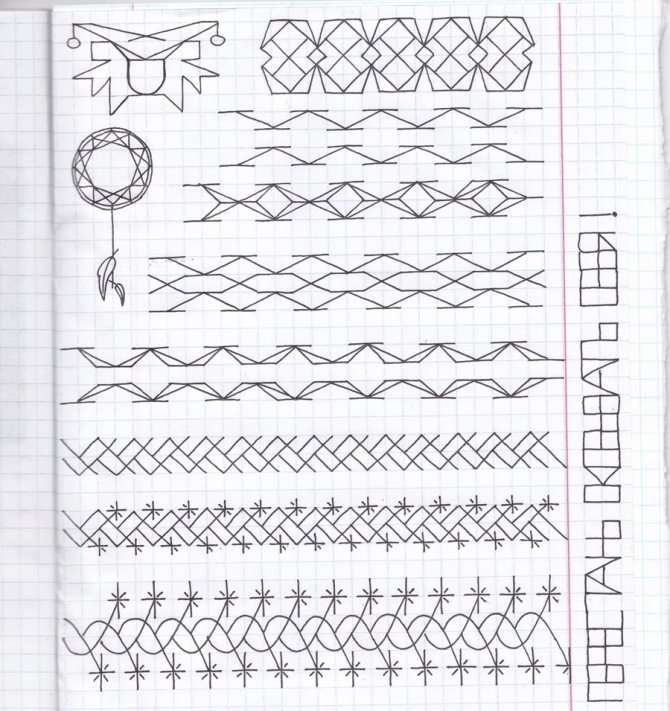
An example of a simple checkered pattern
Symmetrical (mirror) drawing in cells
Mirror drawing in cells invites the child to complete part of the drawing, half of which has already been completed. But not just complete the drawing, but exactly as shown. The finished part can be located on the left or right, or maybe on top or bottom. The second option is more difficult. The child must strictly observe symmetry and draw the number of cells that was initially specified. These tasks are more difficult than others, but they perfectly develop abstract and logical thinking, perseverance and accuracy.
Temporary restrictions
In classes with children of any age, breaks should be taken every ten minutes. You can do a warm-up, read the poem “Our fingers are tired,” stand up to jump or play.
The time frame for classes depends on the child’s age, his perseverance and many other factors.
Typically, classes with children 5 years of age and younger last no more than 15 minutes. Graphic dictations with children 6 years old take 15-20 minutes. With older guys, at least 20 minutes, but no more than half an hour.
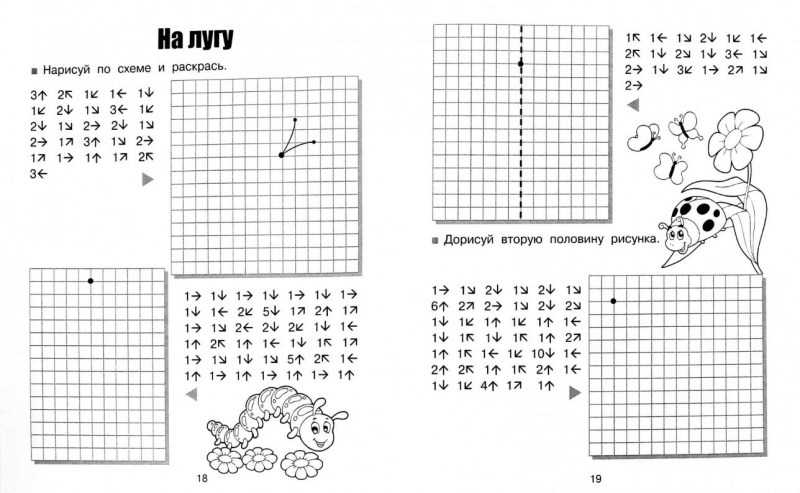
The teacher must monitor the children’s progress himself, changing the time depending on this. Lessons that are too long tire children and reduce their performance, while lessons that are too short will not allow them to learn all the planned material.
Graphic dictations for school preparation
If the presented tasks did not seem enough to you, do not waste time searching for pictures in Yandex or Google.
Printing materials on various sites are often of poor quality, and there are errors in the dictation text, which completely kills the child’s desire to study further.
Here: print out assignments to prepare for school.
Ready-made manuals with graphic dictations are inexpensive and interesting . Here are examples.
Dictations from the book 5+ “Funny Cells. Graphic dictations. To prepare for school."
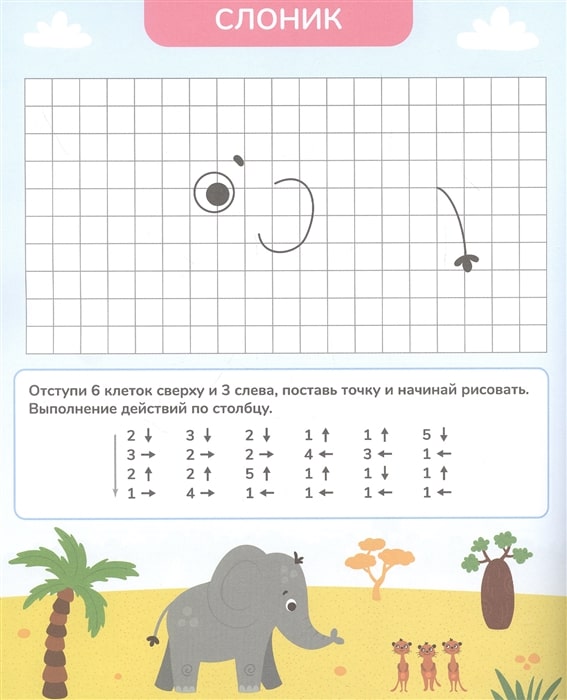
A very interesting set of tasks in Elena Uleva’s manual “Super developmental tasks for first graders. Graphic dictations for first graders"
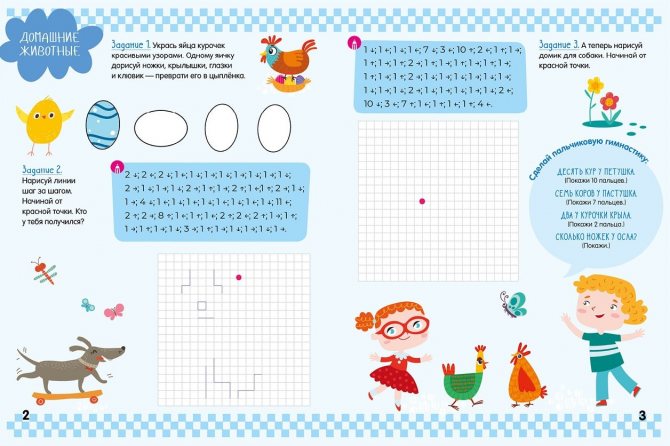
Scans of tasks from the series “Waco. On the way to school. Graphic dictations"
Spreads of the notebook “Graphic dictations. Attention training. 1 class":
From the manual “Graphic dictations. From simple to the most complex. Guidelines for activities with children aged 5-7 years:
Sketching
The child is given a completed drawing and a blank form. The child copies the picture by cells. You need to carefully monitor in which direction and how long the lines go.
It is important to interest the baby in drawing. For younger kids these should be simple templates. Boys may like cars or interesting geometric shapes, girls are happy to draw flowers and patterns.
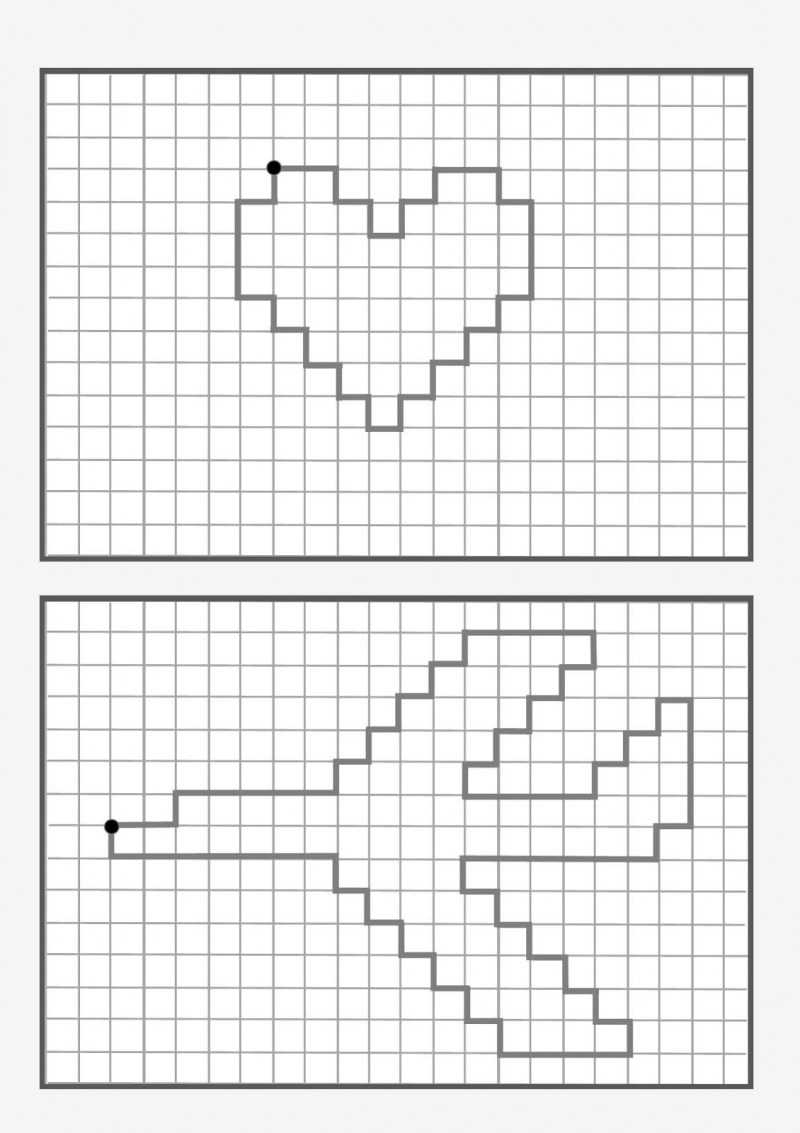
If it’s difficult for a child...
If it is difficult for a child to complete tasks on cells with arrows, perhaps you have simply not yet worked out the meaning of the arrows, the concepts of “right, left, top, bottom.” Start with simple arrow exercises like these to get the vocabulary right.
Drawing according to instructions with arrows
This method differs from dictation by less control on the part of teachers. The child is given a piece of paper with a dot and a small instruction, usually in the form of arrows with the number of cells. The child draws a picture at his own pace.
You can conduct a workshop for beginners and young children to explain how the task is performed. This method perfectly trains perseverance and attentiveness in children.
Print oral graphic dictations with answers
They try to make tasks for oral dictation a little simpler than those tasks that are done “from sight”, since they require more preparation and concentration. There are no diagonal lines in them. They are also provided with a picture answer to quickly show children an image of the correct solution.
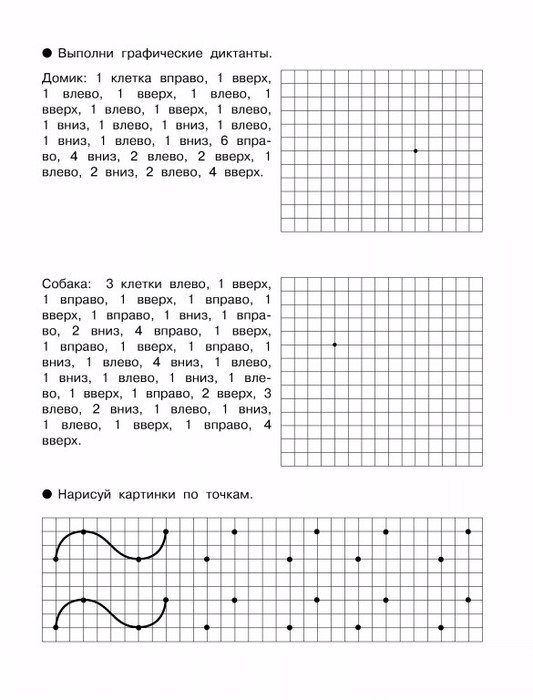
If you find it difficult to unravel abstract images, here is a hint: the following are encrypted: sailboat, dragon, snowflake, bear, lion, car, chair, ladybug, hippopotamus, ship, octopus, hare, snowman, boat, turtle.
Symmetry
The baby is given half of the drawing and must complete the other half himself, maintaining symmetry. The technique affects spatial orientation, thinking, the ability to compare and find one’s own mistakes.
The benefits of the technique
Graphic dictations are often given for 1st grade. It does not matter what type of methodology the teacher or parent uses. The activity has a positive effect on the baby’s abilities and helps him develop the following vital qualities:
- coordination of movements;
- fine motor skills;
- attentiveness;
- perseverance;
- ability to count;
- spatial and abstract thinking;
- graphic skills;
- determination.
In addition, the child learns to adequately assess his successes, perceive instructions by ear and always finish what he has started. The baby expands his horizons and increases his vocabulary. The technique will perfectly help mothers prepare kindergarteners for school.
Study guides with complete instructions can be purchased at office supply stores and bookstores, or downloaded online and printed. Some graphic dictations by cell are attached below.
Graphic exercises are a fairly simple task for preschoolers. Therefore, some mothers consider it unnecessary and useless. But that's not true. Dictations help children gain self-confidence, develop attentiveness and perseverance, so necessary for adaptation to school.
Dictations for independent work
These tasks, where the dictation field and the “path” with arrows are located next to each other, are convenient to use for independent work.
Explain to your child that movement along the arrows begins with a dot. The signs should be read from left to right horizontally .
